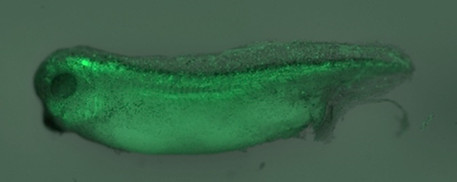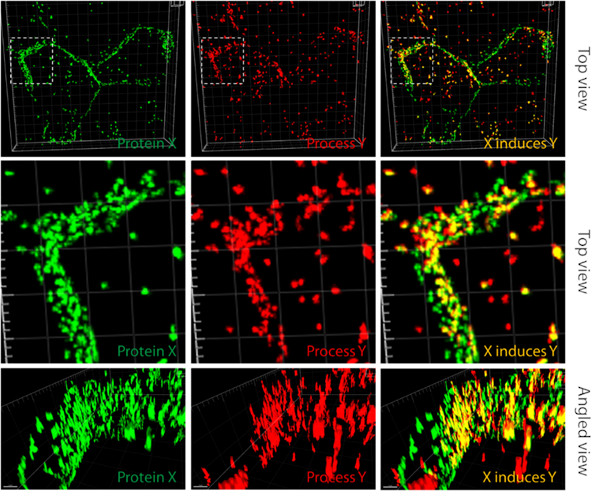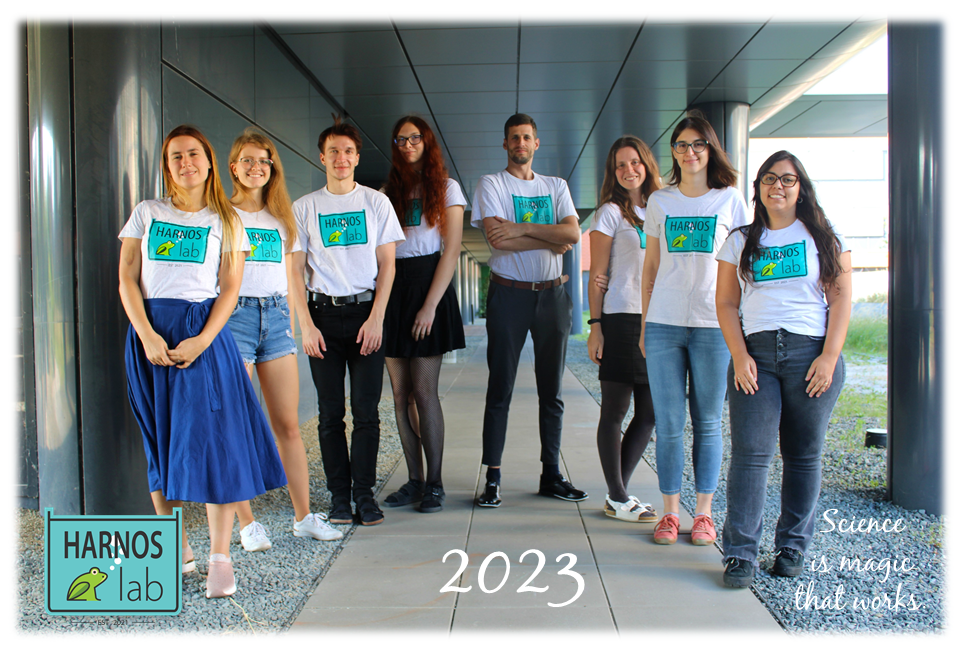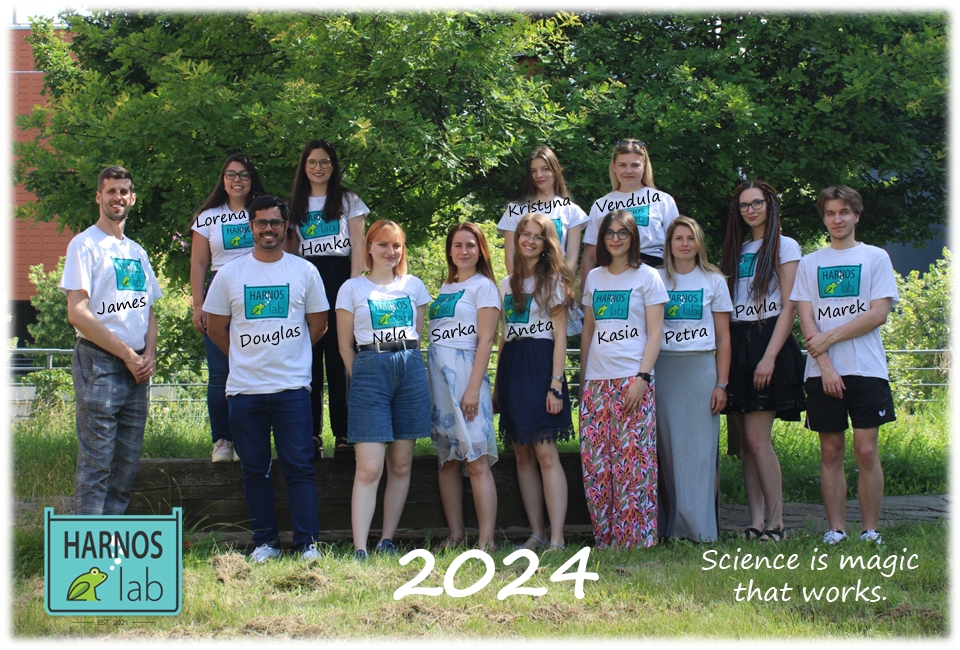——–
What do we work with in our laboratory? We work with early stages of Xenopus frog embryos. 🐸
Why frogs? As you may have noticed in nature, frog embryos are generally relatively large and develop outside the mother’s body, making them excellent for observation under a microscope. 🔬
Why Xenopus and not another frog? Xenopus was used as the first reliable test for fertility in humans. It was called the Hogben test, named after the British scientist Lancelot Hogben, and was used in American and English hospitals from the 1930s until World War II. After biochemical strips replaced these tests, Xenopus frogs became the subject of study in hospitals and scientific centers, becoming the most commonly used amphibian or frog models in biomedical research. 🧪
What do we study in Xenopus frog embryos? We study the formation of the neural tube and the migration of cells in the so-called neural crest. 🧠
————-
PRINCIPAL INVESTIGATOR

Group leader: Assist. Prof. Jakub Harnos, Ph.D.
Office: Campus Bohunice, bldg. D36, rm 1S16
E-mail: harnos@sci.muni.cz
Telephone: +420 549 49 4465
ORCID ID: 0000-0002-0752-9260
————-
Scientific autobiography
My scientific career has been dedicated to exploring WNT signaling pathways, which are crucial for multicellular development and implicated in various diseases when deregulated.
As a Master’s and Ph.D. student, I studied Dishevelled, a key component of WNT signaling, under the supervision of Prof. Vitezslav Bryja. In collaboration with Prof. Carsten Hoffman (University of Wurzburg, Germany), I developed FRET biosensors to monitor Dishevelled’s structural conformation dynamics and analyzed their role in WNT signal transduction.
During my postdoctoral training with Prof. Sergei Sokol in New York, I expanded my expertise in vertebrate embryology and the Xenopus model system, becoming an expert in PCP signaling. I investigated PCP-interacting proteins during neurulation in Xenopus embryos using proximity-dependent biotinylation.
In 2020, I returned to Czechia and assumed the position of Assistant Professor at Masaryk University. My research interests broadened to include vertebrate neurulation and cell migration, focusing on understanding how migrating cells obtain energy. In 2021, I established my research group, which investigates new roles for PCP signaling in bioenergetics and neurulation using cell culture systems and Xenopus embryos. Specifically, we study the roles of cytoplasmic PCP proteins such as Prickle and Dishevelled in these processes, given their versatility in cellular signaling.
This interdisciplinary approach aims to uncover novel mechanisms and potentially improve disease treatments driven by cell migration and neurulation.
Fellowships, Grants, and Awards
*2024 – 2026: Grant in the Standard/Senior category (#24-10622S), Czech Science Foundation, Czechia
2023: Hemsley Fellowship (#203103), Xenopus course, Cold Spring Harbor Laboratories, NY, USA (declined due to family reasons)
*2022 – 2024: Grant in the Standard/Senior category (#22-06405S), Czech Science Foundation, Czechia
*2022 – 2024: Science & Humanities Award Junior (#MUNI/J/0004/2021), Grant Agency of Masaryk University, Czechia
2020: “Seal of Excellence” in MSCA-IF-2020 (#101028952), European Commission, Brussels
2018 – 2019: “Excellent Results” Grant (#MUNI/E/0533/2018), Grant Agency of Masaryk University, Czechia
2017 – 2017: EMBO Short-term Fellowship (#ASTF 687-2016), University of Wurzburg, Germany
2016 – 2016: Mobility program “Free mover”, University of Wurzburg, Germany
*Current funding
————-
RESEARCH TOPIC
Polarity refers to spatial differences in shape, structure, and function within a cell. Almost all cell types exhibit some form of polarity that enables them to carry out specialized functions. We focus on planar polarity, which refers to the coordinated alignment of cells across the tissue plane. Planar polarity is currently viewed as a “passive” compass providing cells with a sense of direction. This feature is important during development when a cell needs to know its position within a multicellular organism, and during homeostasis, when a cell needs to know the direction e.g., for its migration.
Our primary goal is to demonstrate the active role of planar polarity in neural tube formation during vertebrate development. Neural tube formation is an early developmental event that involves approximately two hundred proteins. Although the tube formation is described somewhat well, the factor responsible for its initiation is not yet known. We have gathered evidence that polarity proteins may be the active triggers for initiating neural tube formation.
Our second aim is related to cell migration. Migration is the directed movement of a cell from one place to another and requires an increased amount of energy. The produced energy is utilized to rearrange dedicated regions in a migratory cell, thus allowing its physical movement. However, what initiates the production of the extra energy needed for rearrangements remains a mystery. Here, we intend to show the active role of planar polarity as an energy trigger for cell migration.
In short, assigning dynamic behaviors to polarity proteins in Xenopus embryos and tissue culture systems is the core of the research conducted in the Harnos lab.

LEFT: A developing Xenopus tadpole, whose neural cells have been marked with the green fluorescent protein (GFP).

RIGHT: We investigate cellular processes in which proteins can initiate several subsequent events that we can observe using microscopes.
In the picture, there are two cells expressing green fluorescent protein fused to a protein of our interest. The last picture on the right shows that the green fusion protein co-localizes with the red cellular process, suggesting that protein X induces this particular cellular process Y (images were edited in Imaris software v9.8).
Keywords
Planar polarity, neural tube formation, cell migration, bioenergetics, tissue culture cells, Xenopus embryos.
SCIENTIFIC PAPERS (Harnos lab, * corresponding author)
Radaszkiewicz KA, Sulcova M, Kohoutkova E, and Harnos J*.
The role of Prickle proteins in vertebrate development and pathogeny.
Mol Cell Biochem, 2023, doi: 10.1007/s11010-023-04787-z.
Laznovsky J, Kavkova M, Reis A, Robovska-Havelkova P, Maia LA, Krivanek J, Zikmund T, Kaiser J, Buchtova M, and Harnos J*.
Unveiling Vertebrate Development Dynamics in Frog Xenopus laevis using Micro-CT Imaging.
GigaScience, 2024, doi: 10.1093/gigascience/giae037.
Gonzalez Lopez M, Huteckova B, Lavicky J, Zezula N, Rakultsev V, Fridrichova V, Tuaima H, Nottmeier C, Petersen J, Kavkova M, Zikmund T, Kaiser J, Lav R, Star H, Bryja V, Henyš P, Vořechovský M, Tucker AS, Harnos J, Buchtova M, Krivanek J*.
Spatiotemporal monitoring of hard tissue development reveals unknown features of tooth and bone development.
Sci Adv 2023, doi: 10.1126/sciadv.adi0482.
RESEARCH TEAM
- Postdoctoral fellows
- PhD students
- Lab technician
- Mgr. Julie Netusilova (currently on maternity leave)
- Dr. Douglas Porto Pereira Gomes
- Undergraduates
- Alumni
- Mgr. Petra Paclikova, Ph.D. (2024; currently a postdoc in Cajanek lab, MUNI, Czechia)
- Ing. Mgr. Vendula Janouskova (2023-2024; currently a Ph.D. student, Prague, Czechia)
- Mgr. Marie Sulcova, Ph.D. (2022-2023; currently a postdoc at the University of Stockholm, Sweden)
- Alba Hernández Ramos (2022-2023, Erasmus student, a practical 10-month stay, University of Salamanca, Spain)
- Mgr. Eliska Kohoutkova (2022-2023; currently a Ph.D. student at Vienna Biocenter, Austria)
- Cristina González Cuevas (2022, Erasmus student, a practical 3-month stay, University UFV in Madrid, Spain)
- Belén Escalona Pulido (2022, Erasmus student, a practical 4-month stay, University UFV in Madrid, Spain)
- Miriam Sánchez Calvo (2022, Erasmus student, a practical 4-month stay, University UFV in Madrid, Spain)



CONFERENCES (POSTER PRESENTATIONS)
- Revealing the mechanism of the neural tube formation. AGOSTINI MAIA, Lorena a Jakub HARNOŠ. Revealing the mechanism of the neural tube formation. In 2nd Conference of Signalling in Disease and Development. 2024.
- Wnt-Notch crosstalk and its impact on embryonic epidermis development using Xenopus embryos. SUCHÁNKOVÁ, Hana, Kristýna Daniela KRUŤOVÁ, Marek DOKOUPIL, Lorena AGOSTINI MAIA, Fabio TURETTI, Jan MAŠEK a Jakub HARNOŠ. Wnt-Notch crosstalk and its impact on embryonic epidermis development using Xenopus embryos. In 2nd Conference of Signalling in Disease and Development. 2024.
- BEE-ST Method: 4D-Monitoring of biomineralization dynamics in bones and teeth. GONZÁLEZ LÓPEZ, Marcos, Barbora HUTEČKOVÁ, Josef LAVICKÝ, Nikodém ZEZULA, Vladislav RAKULTSEV, Vendula FRIDRICHOVÁ, Haneen Riadh Ali TUAIMA, Citta NOTTMEIER, Julian PETERSEN, Michaela KAVKOVÁ, Tomas ZIKMUND, Jozef KAISER, Rupali LAV, Haza STAR, Petr HENYS, Miroslav VORECHOVSKY, Vítězslav BRYJA, Abigail S. TUCKER, Jakub HARNOŠ, Marcela BUCHTOVÁ a Jan KŘIVÁNEK. BEE-ST Method: 4D-Monitoring of biomineralization dynamics in bones and teeth. In 3rd Conference of the Visegrad Group Society for Developmental Biology. 2023.
- Linking Wnt to Notch signaling using vertebrate embryos. ŠULCOVÁ, Marie, Fabio TURETTI, Marek DOKOUPIL, Jakub HARNOŠ a Jan MAŠEK. Linking Wnt to Notch signaling using vertebrate embryos. In 3rd Conference of the Visegrad Group Society for Developmental Biology. 2023.
- Understanding the Role of Casein Kinase 1α in the regulation of the Notch1 intracellular domain. ŠULCOVÁ, Marie, Hana HAJSMANOVA, Tomáš GYBEĽ, Vítězslav BRYJA, Jakub HARNOŠ a Jan MASEK. Understanding the Role of Casein Kinase 1α in the regulation of the Notch1 intracellular domain. In The Notch Meeting XII. 2023.
- Micro CT analysis of head development in Xenopus laevis. KAVKOVÁ, Michaela, Jakub HARNOŠ, Marie ŠULCOVÁ, Tomas ZIKMUND, Marcela BUCHTOVÁ a Josef KAISER. Micro CT analysis of head development in Xenopus laevis. In 19th International Congress of Developmental Biology. 2022.
- Seeking Help from Mitochondrial Biologists to Decipher the Role of New Mitochondrial Interactors. RADASZKIEWICZ, Katarzyna Anna, Aneta POUKOVÁ, Pavla KOLÁŘOVÁ a Jakub HARNOŠ. Seeking Help from Mitochondrial Biologists to Decipher the Role of New Mitochondrial Interactors. In Mitochondria in life, death and disease. 2022.
COLLABORATIONS
- Germany:
– Prof. Carsten Hoffmann (Maximilians University,Wurzburg/University Hospital, Jena)
– Prof. Alexandra Schambony (Max Planck Institute for Science of Light, Erlangen)
Previous collaborations led to my first-authored Nat Comm 2019 manuscript about Dishevelled
- USA:
– Prof. Sergei Sokol (Icahn School of Medicine at Mount Sinai, New York):
Active collaboration on neurulation and PCP signaling in developing Xenopus embryos
–
– Dr. Giovanna Collu (Icahn School of Medicine at Mount Sinai, New York):
Active collaboration in the context of WNT-Notch crosstalk
- Czechia:
– Assoc. Prof. Lukas Trantirek (CEITEC, Brno):
The previous collaboration led to my first-authored JBC 2018 manuscript about Axin
Active collaboration on DNA quadruplex structures analyzed by NMR techniques in Xenopus oocytes
– Prof. Zbynek Zdrahal (CEITEC, Brno):
The previous collaboration led to my first-authored Nat Comm 2019 manuscript about Dishevelled
Active collaboration on proximity biotinylation approaches using Mass Spectrometry
– Dr. Jan Masek (Charles University, Prague):
Active collaboration on cilia formation in Xenopus in the context of WNT-Notch crosstalk
We are actively recruiting talent of all levels, from Bachelor’s and Master’s students to PhDs and Postdocs.
Write an email with your CV and a short motivation letter to harnos@sci.muni.cz
Follow us on Twitter for the latest news and updates: